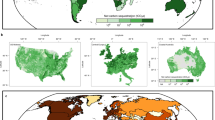Abstract
A worldwide shift from current diets to the planetary health diet proposed by the EAT–Lancet Commission would have direct implications for agricultural greenhouse gas (GHG) emissions. By modelling the trajectory of food from cradle to farm gate while accounting for international trade, we estimate that agricultural GHG emissions would decrease in 101 countries as well as globally. Yet, in primarily low- and middle-income countries, agricultural GHG emissions would increase by 12–283%. Country-specific impacts of dietary transitions should be considered in climate change mitigation policy.
This is a preview of subscription content, access via your institution
Access options
Access Nature and 54 other Nature Portfolio journals
Get Nature+, our best-value online-access subscription
$29.99 / 30 days
cancel any time
Subscribe to this journal
Receive 12 digital issues and online access to articles
$119.00 per year
only $9.92 per issue
Buy this article
- Purchase on Springer Link
- Instant access to full article PDF
Prices may be subject to local taxes which are calculated during checkout


Similar content being viewed by others
Data availability
Data used in adapting the EAT–Lancet diet are provided in Supplementary Data Tables 1, 2, 6 and 7. Data used in modelling GHG emissions are provided via Mendeley Data: https://data.mendeley.com/datasets/g8n8w8snmj/3.
Code availability
Python scripts used for modelling GHG emissions are available from M.W.B. upon reasonable request (e-mail: mbloem1@jhu.edu).
References
Willett, W. et al. Food in the Anthropocene: the EAT–Lancet Commission on healthy diets from sustainable food systems. Lancet 393, 447–492 (2019).
The Planetary Health Diet (EAT–Lancet, accessed 15 December 2019); https://eatforum.org/learn-and-discover/the-planetary-health-diet/
Reisinger, A. & Clark, H. How much do direct livestock emissions actually contribute to global warming? Glob. Change Biol. 24, 1749–1761 (2018).
Godfray, H. C. J. et al. Meat consumption, health, and the environment. Science 361, eaam5324 (2018).
Kim, B. F. et al. Country-specific dietary shifts to mitigate climate and water crises. Glob. Environ. Change 62, 101926 (2020).
Global Health Observatory (GHO) Data (World Health Organization, accessed 19 December 2019); https://www.who.int/gho/en/
Pelletier, D. L., Frongillo, E. A. Jr., Schroeder, D. G. & Habicht, J. P. The effects of malnutrition on child mortality in developing countries. Bull. World Health Organ. 73, 443–448 (1995).
Popkin, B. M., Corvalan, C. & Grummer-Strawn, L. M. Dynamics of the double burden of malnutrition and the changing nutrition reality. Lancet 395, 65–74 (2020).
Hirvonen, K., Bai, Y., Headey, D. & Masters, W. A. Affordability of the EAT–Lancet reference diet: a global analysis. Lancet Glob. Health 8, e59–e66 (2020).
Baldi, G. et al. Cost of the Diet (CoD) tool: first results from Indonesia and applications for policy discussion on food and nutrition security. Food Nutr. Bull. 34, S35–S42 (2013).
Headey, D. D. & Alderman, H. H. The relative caloric prices of healthy and unhealthy foods differ systematically across income levels and continents. J. Nutr. 149, 2020–2033 (2019).
FAOSTAT (Food and Agriculture Organization of the United Nations, 2017); http://www.fao.org/faostat/en/
Gustavsson, J., Cederberg, C., Sonesson, U. & Emanuelsson A. The Methodology of the FAO Study: “Global Food Losses and Food Waste – Extent, Causes and Prevention”- FAO, 2011 (The Swedish Institute for Food and Biotechnology, 2013).
GLEAM-i, version 2.0, revision 3 (Food and Agriculture Organization of the United Nations, 2017); http://www.fao.org/gleam/resources/en/
Global Livestock Environmental Assessment Model, version 2.0, model description revision 4 (Food and Agriculture Organization of the United Nations, 2017).
Acknowledgements
This work was supported by the Santa Barbara Foundation (https://www.sbfoundation.org/). The funders had no role in preparing, reviewing or editing the manuscript.
Author information
Authors and Affiliations
Contributions
R.D.S., M.W.B. and K.N. designed the study. B.K. conducted the analysis and produced the figures. S.d.P., S.M., M.W.B., B.K. and K.N. contributed to data interpretation. R.D.S. wrote the paper. M.W.B., S.d.P., S.M., K.N. and B.K. edited the paper.
Corresponding author
Ethics declarations
Competing interests
The authors declare no competing interests.
Additional information
Publisher’s note Springer Nature remains neutral with regard to jurisdictional claims in published maps and institutional affiliations.
Supplementary information
Supplementary Table 1
Composition of the planetary health diet for an intake of 2,500 kcal d−1.
Supplementary Table 2
Adoption of the planetary health diet and per capita GHG emission in 151 countries and territories with overweight and stunting prevalence in each country.
Supplementary Data
Supplementary Data.
Rights and permissions
About this article
Cite this article
Semba, R.D., de Pee, S., Kim, B. et al. Adoption of the ‘planetary health diet’ has different impacts on countries’ greenhouse gas emissions. Nat Food 1, 481–484 (2020). https://doi.org/10.1038/s43016-020-0128-4
Received:
Accepted:
Published:
Issue Date:
DOI: https://doi.org/10.1038/s43016-020-0128-4
This article is cited by
-
Association between adherence to the EAT-Lancet sustainable reference diet and cardiovascular health among European adolescents: the HELENA study
European Journal of Clinical Nutrition (2024)
-
Low-carbon diets can reduce global ecological and health costs
Nature Food (2023)
-
Models can enhance science–policy–society alignments for climate change mitigation
Nature Food (2023)
-
Global food nutrients analysis reveals alarming gaps and daunting challenges
Nature Food (2023)
-
Enhanced food system efficiency is the key to China’s 2060 carbon neutrality target
Nature Food (2023)



